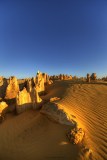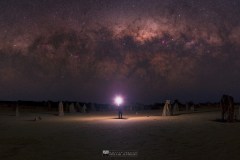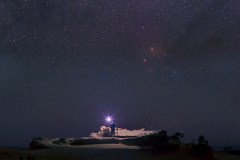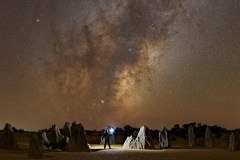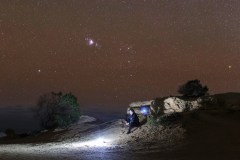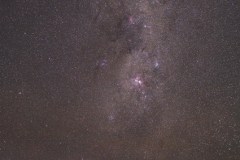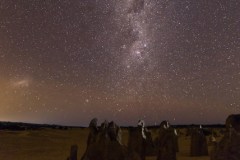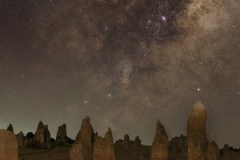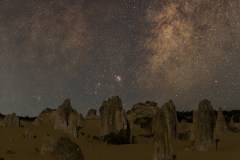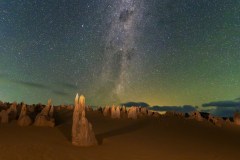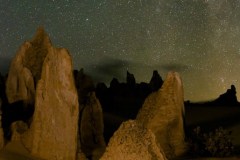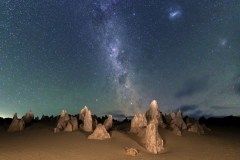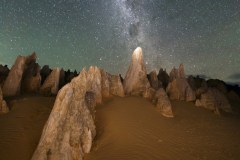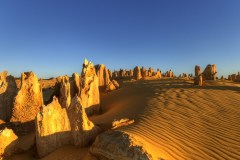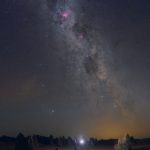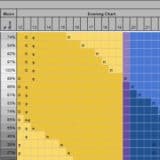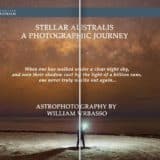The Pinnacles
by admin · December 2, 2018

Location Details
Scroll to bottom of page for images and posts
How can one describe the Pinnacles? It seems like an alien landscape, where yellow / brown sand sifts silently in the breeze and flowing between large fields of rock monoliths that stand up to 3 metres tall in places. At night the stars shine down upon the tall stone columns, casting them in a pale light. And walking between them, alone under the darkness of the night and the brilliance of the Milkyway galaxy arching above, one cannot help but think that you are on another world – ancient and lonely. These are the Pinnacles situated in Nambung National Park, some 2.5 hours north of Perth near the coastal town of Cervantes, and it is a unique landscape that has no peer in the region.
The Pinnacles are formed from limestone that was deposited by seashells in an earlier era that was rich in marine life. These shells were for the most part grinded down into limestone sands and blown inland to form high mobile dunes. However, the manner in which such raw materials formed the Pinnacles is the subject of debate. There are a few theories on how the Pinnacles formed, from root casts of long gone trees to cemented void infills formed by microbialites. Looking close-up to the Pinnacles you can see both the small encrusted features of smaller seashells, but also thin tube-like structures that look like they were once roots.
Summary Info
CATEGORY: Other (unique)
RATING: Excellent
ACCESS: 2wd, very good dirt track
FEATURES: unique limestone formations over a large desert like area..
CONSTRAINTS: no camping, popular with night tourists.
SUMMARY: Unique and other-worldly, the hundred of monolith-like rock formations provide an abundance of compositions. A must see for anyone in daylight or darkness...
Google Maps
The Pinnacles can be reached by travelling north from Perth along the scenic Indian Ocean drive for about 2.5 hours. Just before the town of Cervantes is a well signed turn-off that leads to the Pinnacles desert. This is a 5 minute sealed road drive to the Pinnacles car-park as well as a visitors centre. Prior to the car-park is a self-payment facility for entering the Pinnacles – please pay and support this wonderful park.
Whilst there is a car-park, this is not where you want to stop. Continuing on there is the actual entrance to the Pinnacles proper. This is a dirt track (but easily navigable by 2wd cars) and goes in a wide loop through the scenic parts of the monolithic fields of stone before returning back to the car-park. Along this track are frequent parking bays so one can stop at various locations to get out and walk amongst Pinnacles and explore.
It is recommended going to the Pinnacles in the late afternoon when it is not so hot (at least in summer months) but allowing enough time to thoroughly scout the area for prospective nightscape compositions. The night skies over the park are very dark allowing unrestricted nightscapes. Only the distant town of Cervantes to the north produces some light pollution, but this is small and can be discounted for the most part.
At night, the Pinnacles is a popular spot for night tourists and other astrophotographers – particularly on weekends. Whilst you may be lucky to have the Pinnacles to yourself, pretty much every time I’ve visited there has always been one or two other visitors. However, the park is large and there is room for all – but if you go expecting some solitude then you are better off going during the week sometime.
The type of nightscapes one can shoot at the Pinnacles is definitely weighted towards wide-angle lenses close-in amongst the Pinnacles. With these shots one can take in the detail of the stone monoliths (particularly if you like light-painting, although not my preference) as well as the night sky above. Large panoramas can be mixed as these compositions tend to reduce the impact of the foreground objects, turning the large Pinnacles into small, dark “bumps”. Those who like using longer focal lengths may have harder trouble trying to find spots that are far enough from the Pinnacles to avoid excessive focus stacking.
There are the odd small hills that can be used as vantage points, but I haven’t personally had too much success with getting good shots from these.
In winter, if one can brave the cold, the Milkyway core is fantastically bright overhead. This is the spot that I first became hooked on the “nightscape” aspect of astrophotography, having taken a very luck shot of the Milkyway vertical over a couple of monoliths during a trip that was taken more on impulse then any real planning. I have yet to really produce and image at the Pinnacles that captures the wonder of this shot (shown here) – even though later shots might be called technically better. Despite being a popular spot for nightscape photography, I still would recommend that all astrophotographers at least visit this place once to experience the unique and wonderous landscape that is the Pinnacles.
Whilst there is no issues staying after dark to enjoy the night at the Pinnacles, there is strictly no camping in the park. For those wishing to sleep part of the night, there are accomodations at the nearby town of Cervantes not far away.
Posts of Location


